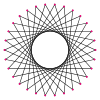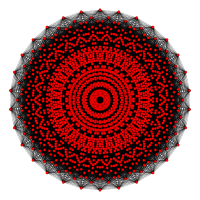Triacontagon
| Regular triacontagon | |
|---|---|
|
A regular triacontagon | |
| Type | Regular polygon |
| Edges and vertices | 30 |
| Schläfli symbol |
{30} t{15} |
| Coxeter diagram |
|
| Symmetry group | Dihedral (D30), order 2×30 |
| Internal angle (degrees) | 168° |
| Dual polygon | self |
| Properties | convex, cyclic, equilateral, isogonal, isotoxal |
In geometry, a triacontagon is a thirty-sided polygon. The sum of any triacontagon's interior angles is 5040 degrees.
The regular triacontagon is a constructible polygon, by an edge-bisection of a regular pentadecagon, and can also be constructed as a truncated pentadecagon, t{15}.
Regular triacontagon properties
One interior angle in a regular triacontagon is 168°, meaning that one exterior angle would be 12°. The triacontagon is the largest regular polygon whose interior angle is the sum of the interior angles of smaller polygons: 168° is the sum of the interior angles of the equilateral triangle (60°) and the regular pentagon (108°).
The area of a regular triacontagon is (with t = edge length)
The inradius of a regular triacontagon is
The circumradius of a regular triacontagon is
Construction
A regular triacontagon is constructible using a compass and straightedge.[1]
Triacontagram
A triacontagram is a 30-sided star polygon. There are 3 regular forms given by Schläfli symbols {30/7}, {30/11}, and {30/13}, and 11 compound star figures with the same vertex configuration.
| Form | Compounds | Star polygon | Compound | ||||
|---|---|---|---|---|---|---|---|
| Picture | .svg.png) {30/2}=2{15} |
.svg.png) {30/3}=3{10} |
.svg.png) {30/4}=2{15/2} |
.svg.png) {30/5}=5{6} |
.svg.png) {30/6}=6{5} |
 {30/7} |
.svg.png) {30/8}=2{15/4} |
| Interior angle | 156° | 144° | 132° | 120° | 108° | 96° | 84° |
| Form | Compounds | Star polygon | Compound | Star polygon | Compounds | ||
| Picture | .svg.png) {30/9}=3{10/3} |
.svg.png) {30/10}=10{3} |
 {30/11} |
.svg.png) {30/12}=6{5/2} |
 {30/13} |
.svg.png) {30/14}=2{15/7} |
.svg.png) {30/15}=15{2} |
| Interior angle | 72° | 60° | 48° | 36° | 24° | 12° | 0° |
There are also isogonal triacontagrams constructed as deeper truncations of the regular pentadecagon {15} and pentadecagram {15/7}, and inverted pentadecagrams {15/11}, and {15/13}. Other truncations form double coverings: t{15/14}={30/14}=2{15/7}, t{15/8}={30/8}=2{15/4}, t{15/4}={30/4}=2{15/4}, and t{15/2}={30/2}=2{15}.[2]
| Quasiregular | Isogonal | Quasiregular Double coverings | ||||||
|---|---|---|---|---|---|---|---|---|
 t{15} = {30} |
 |
 |
 |
 |
 |
 |
 |
 t{15/14}=2{15/7} |
 t{15/7}={30/7} |
 |
 |
 |
 |
 |
 |
 |
 t{15/8}=2{15/4} |
 t{15/11}={30/11} |
 |
 |
 |
 |
 |
 |
 |
 t{15/4}=2{15/2} |
 t{15/13}={30/13} |
 |
 |
 |
 |
 |
 |
 |
 t{15/2}=2{15} |
Petrie polygons
The regular triacontagon is the Petrie polygon for three 8-dimensional polytopes with E8 symmetry, shown in orthogonal projections in the E8 Coxeter plane. It is also the Petrie polygon for two 4-dimensional polytopes, shown in the H4 Coxeter plane.
| E8 | H4 | |||
|---|---|---|---|---|
 421 |
 241 |
 142 |
 120-cell |
 600-cell |
The regular triacontagram {30/7} is also the Petrie polygon for the great grand stellated 120-cell and grand 600-cell.
References
- ↑ Constructible Polygon
- ↑ The Lighter Side of Mathematics: Proceedings of the Eugène Strens Memorial Conference on Recreational Mathematics and its History, (1994), Metamorphoses of polygons, Branko Grünbaum
| ||||||||||||||||||||||||||



